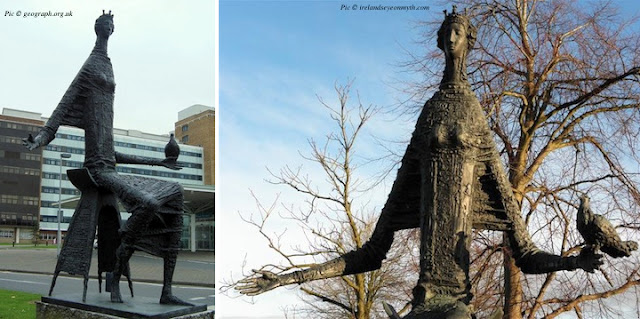I've long been fascinated by shining stones,
cloche geala, the bright, white stones which appear throughout the ancient architecture, folklore and mythology of Ireland.
Also known as
grian cloche, sun stones, they are white quartz, clear crystal and quartzite stones which
most famously appear on the monuments of the Boyne Valley.
Shining stones, used in the modern facade of Newgrange
& at the entrance to Knowth nearby, were discovered during excavations.
The Silva Gadelica of 1892 describes the mound as "chequered with the many lights” and it is easy
to imagine how impressive the quartz covered mound would have originally been when it glowed
in sunlight and beneath a full moon.
Quartz stones were erected in many places on the island and finds of shining stones occur at almost all of the ancient, sacred sites excavated here.
 |
Poundcartron, Co. Galway Photo by Gerard Bleeker .
Not confined to construction, quartz crystals and white stones were also left inside mounds to lie
with the dead.
Excavations in Cairn T on Sliabh na Caillí, Loughcrew revealed a clear quartz crystal, drilled
& used as a pendant. Poulnabrone, across the country, held two such crystals amongst other artefacts.
Why were these shining stones so important to our ancestors?
One answer may lie in a special property of quartz, its' triboluminescence.
This means that when one piece of quartz is rubbed against another, in the dark,
a bright yellow-orange light can be seen.
The Uncompahgre Ute people of Central Colorado created ceremonial rattles made from
buffalo rawhide filled with clear quartz crystals. When shaken during night time ceremonies,
flashes of light could be seen through the translucent hide.
In a similar way quartz may have been used in the ancient rituals of Ireland.
|
Perhaps this characteristic was understood as a living fire, akin to sunlight, within the stone ?
Or maybe the stone was believed to house the spirits of the departed awaiting rebirth?
***
Folklore also provides us with insights into shining stones.
In the same way that the fairy folk were known as
daoine uaisle, good people /gentry,
white quartz was called
cloche uaisle, gentle or noble stone and associated with fairies, their
mounds and the dead.
This practice of cursing, especially using nine white stones in a fire, was used in many areas.
It was understood that misusing these stones in this way would awaken the ire of the Good People
who would vent their anger upon the cursed one.
White stones however could be used to heal as well as harm.
Quartz crystal amulet encased in silver,
15th century from The National Museum of Ireland.
Amulets were dipped in specially collected water and used in healing rituals.
Fairy doctors and
WISE WOMEN, in contact with the Good People, were said to use white quartz and crystals to cure sick people and animals.
A cure for boils involved reddening nine white quartz stones in the fire then placing them into a pot
of boiling water and sage.
The Shrine of Miosach.
Later sacred quartz was used in the decoration of Christian shrines
to protect relics and some were thought to have the power to heal.
The beliefs and rituals associated with shining stones were adapted by the early Christian church
with stones used on saints' beds, graves and at holy wells.
Skour Well. Co. Cork with Christian icons, a Rag Tree and shining stones.
On May eve,
Bealtaine, pilgrims would make rounds at the well and leave a white stone.
White quartz is revered by many communities often marking rites of passage.
This is "The Tinkers' Heart", a pattern of quartz stones laid at an Argyll crossroads in Scotland
during the 1700's. Since then it has been used by generations of Travellers as a sacred place
to bless their children and hold weddings.
Across time, from the Neolithic to today, there appears to be continuity in the beliefs and traditions associated with shining stones.
Although we will never know the meaning of quartz to our ancestors it appears to be connected with sacred ground, ritual fires, the Otherworld and possibly the rebirth of the spirit.
We find white quartz chippings on modern graves,
cloche gaela left at holy places in the landscape,
Offerings left at Drombeg Stone Circle Co. Cork, known locally as the Druid’s Altar.
and quartz crystals used in healing and as tools to 'see' the future.

















































